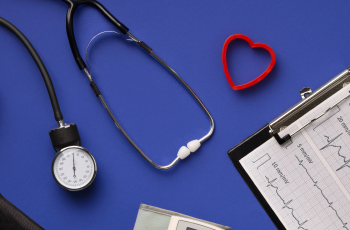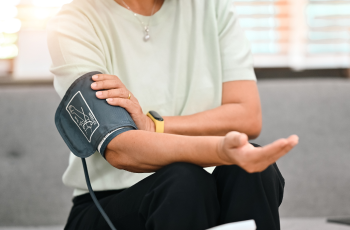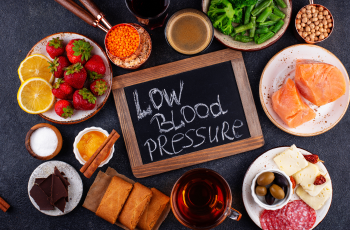Hypotension vs Hypertension
Written By: Dr Nelson Lau, MBBS FRACGP, GP and Digital Health Specialist
As blood circulates through the cardiovascular system, it exerts a force known as blood pressure on artery walls. Two conditions – hypertension and hypotension – refer to the scenarios where blood pressure veers too high or too low respectively. Understanding the implications of blood pressure variations is important in helping us proactively preserve our long-term health.
Hypertension Meaning: What Is Hypertension?
Hypertension, also called high blood pressure, occurs when the force exerted by blood flowing through arteries consistently remains raised above normal thresholds, putting strain on blood vessels and the heart. This pressure results due to the interactions between the volume of blood pumped and the size and elasticity of the arteries carrying it. Like air in a balloon, higher pressure from increased blood volume or constricted, rigid vessels cause an increase in the force inside the balloon. Just as an overinflated balloon grows strained, chronic hypertension places strain on the arteries, organs and other tissues that depend on receiving vital oxygen-rich blood, increasing the risk of serious diseases like aneurysms, kidney disease and stroke over time.
Types Of Hypertensions
High blood pressure, known medically as hypertension, can manifest in different forms. The most common is called essential hypertension. It tends to develop slowly over many years, often without a single clear cause. Essential hypertension accounts for the majority of high blood pressure cases in adults. Another form is called secondary hypertension. It is caused by an underlying medical issue and can lead to sudden spikes in blood pressure readings. Things like kidney disorders, certain medications, or other health conditions may trigger secondary hypertension. Finally, some people experience higher readings only in clinical settings, likely due to nerves about visiting the doctor. That phenomenon, termed white coat hypertension, is important to distinguish from chronic high blood pressure, since the treatment methods could be different. These three varieties encompass the range of hypertension types. While their causes and treatments vary, ongoing management is crucial for every patient with elevated blood pressure.
There are 2 stages of hypertension.
- Stage 1 Hypertension: When blood pressure readings stay between 130-139 systolic or 80-89 diastolic, a patient is considered to have Stage 1 hypertension. Though it elevates heart disease and stroke odds, modified lifestyle or medication can help to manage their risk.
- Stage 2 Hypertension: At 140+ systolic or 90+ diastolic readings, the more severe Stage 2 hypertension sets in. The heightened risk of cardiovascular disease frequently necessitates combined medication and lifestyle shifts to reach safer levels.
Hypertension Symptoms and Causes
In Australia, the prevalence of hypertension has been associated with certain dietary and lifestyle factors such as high dietary salt intake, obesity, smoking, chronic stress, and lack of exercise. Advancing age and family history also contribute to individual risk profiles. Dubbed the ‘silent killer’ because symptoms rarely present themselves until advanced stages, hypertension deserves regular screening by your GP and prompt intervention if discovered. However, in some acute cases of hypertension, symptoms may include chest pain, headache, blurred vision, dizziness and shortness of breath.
Hypertension Treatments and Diagnosis
Management of hypertension typically involves medications to relax blood vessels, paired with lifestyle adjustments like a healthier diet, regular exercise, smoking cessation and stress management. Tracking blood pressure is also key for assessing the effectiveness of treatment measures and there are now portable blood pressure monitors that can easily help patients do so.
Hypotension Symptoms and Causes: What Happens When You Have Hypotension?
With hypotension, reduced blood flow can momentarily deprive the brain, heart and other areas of oxygen and nutrients. While not universally problematic, this can generate unpleasant acute symptoms like light-headedness, blurry vision, fatigue or fainting. Research has shown that sustained low blood pressure may also be related to depression and reduced kidney function.
Hypotension Diagnosis and Treatment
Beyond symptoms, comparing blood pressure readings against reference ranges for age and health status provides objective means for clinical hypotension diagnosis. Potential causes of hypotension include dehydration, blood loss, pregnancy, heart conditions slowing output (such as heart failure), sepsis and side effects of medications like diuretics or anxiety treatments.
As with a leaking pipe in an irrigation network, locating and resolving the source of pressure loss is the primary treatment goal. Increasing fluid intake, adding salt to the diet, wearing leg compression garments or adjusting medications represent common intervention pathways for stabilisation. Severe low blood pressure warrants advanced medical care to identify underlying causes and provide appropriate treatment.
Exams And Tests for High and Low Blood Pressure
Carefully tracking blood pressure is key for properly managing high or low readings. Doctors have several methods to diagnose these conditions and monitor any treatment plans.
High Blood Pressure
- Pressure Checks: The main test for high blood pressure involves measuring readings with a blood pressure cuff. Results help categorise levels as normal, elevated, or indicators of stage 1 or 2 hypertension.
- Daytime Monitoring: This uses a portable device to record pressure fluctuations over 24 hours during regular activities. It can identify masked hypertension or cases confined to doctor visits.
- Home Monitoring: Tracking readings at home helps patients watch for medication effectiveness and broader trends. Doctors often recommend this for those at risk or with a diagnosis.
- ECG and Echocardiogram: These tests can detect any electrical or structural heart problems that could be related to high blood pressure.
- Other Tests: These can check for accompanying issues like high cholesterol, kidney dysfunction, or diabetes as possible causes or complications.
Low Blood Pressure
- Pressure Checks: Readings below normal levels on a blood pressure cuff indicate hypotension, or low pressure.
- Postural Changes: Measuring blood pressure and heart rate while moving from lying to standing (Tilt Table Test) checks for pressure drops related to postural or neurally mediated hypotension.
- Additional Tests: Blood tests for anaemia, blood sugar, or thyroid problems may uncover an underlying contributor. Heart tests such as an ECG or echocardiogram may help if that is the suspected cause.
Ongoing monitoring is vital for both high and low blood pressure patients. Doctors will choose testing methods based on symptoms, readings, and medical history. Regular follow-ups to adjust treatment are key for proper management.
Interpreting Blood Pressure Readings
The two values reporting blood pressure decode the interaction of the heart’s cycles with arteries:
- Systolic – The higher value marking peak pressure against arteries as the heart contracts to push blood out.
- Diastolic – The lower value conveying resting pressure on artery walls between heartbeats as chambers refill.
Typical readings for healthy young adults average around 120 mmHg systolic over 80 mmHg diastolic. However, evaluating high or low diagnoses requires considering age-specific norms and individual health profiles. Ongoing monitoring and follow-up with your GP will help to personalise your blood pressure management.
Lifestyle Factors Impacting Blood Pressure
Regardless of starting point, certain practices exert beneficial or detrimental effects on blood pressure:
- Sodium – Restricting salt intake can lower blood pressure.
- Exercise & weight – Staying active and maintaining healthy weight promotes vascular function.
- Alcohol & smoking – Limiting or avoiding use supports healthy circulation.
- Stress – Managing chronic anxiety and tension alleviates strain on the heart.
Frequently Asked Questions
What is dangerously low blood pressure?
What constitutes low blood pressure can vary from person to person. While there is no universal threshold, symptoms can offer important clues. Feeling occasional light-headedness or dizziness may not be a cause for concern. However, experiencing fatigue, blurred vision, nausea or fainting warrants medical evaluation – even if such episodes quickly resolve.
In assessing low blood pressure, doctors consider associated factors and the patient’s medical history, and change in the blood pressure over time. Acute drops in blood pressure often stem from dehydration, medication effects or other reversible causes. But they can sometimes indicate underlying cardiac, endocrine or neurological disorders.
Though not universally defined, experts view blood pressure under 90/60 mmHg as notably low in most adults. Regardless of the blood pressure reading number, significant drops in one’s normal baseline or the emergence of bothersome symptoms should prompt medical attention. With appropriate diagnosis, the causes of low blood pressure can often be successfully managed.
How do you treat low blood pressure?
Approaches for managing low blood pressure depend on the cause and severity of the symptoms. Simple dehydration may resolve with increased fluid intake. However, treatment of underlying cardiac or endocrine disorders can be a more complex situation.
Regardless of the cause, certain lifestyle measures can provide symptom relief. Consuming adequate salts, wearing compression stockings and moving slowly from laying down, may worsen light-headedness for those prone to blood pressure dips on standing. Small frequent meals are also preferred to large ones for those with low blood pressure.
While some adopt a do-it-yourself approach, medical consultation is strongly advisable before starting any new regimens. Increasing salt intake and other tactics can adversely affect some conditions. Doctors also monitor for blood pressure trends that are best managed with medication.
In essence, low blood pressure treatment requires a proper diagnosis from your General Practitioner and specialists. Lifestyle tweaks may help, but safety stems from individualised clinical partnerships to address the root causes. Prevention of fainting and related injuries remains the ultimate goal to keep the patient safe.
Can drinking water lower blood pressure?
Staying well hydrated can help lower blood pressure. Here are some key points about how drinking more water may improve blood pressure:
- Dehydration causes blood volume and blood pressure to rise. Drinking adequate water helps prevent dehydration, allowing blood pressure to remain in a healthier range. Even mild dehydration can cause significant blood pressure rises.
- Drinking more water may promote blood vessel elasticity and function. Some research indicates staying hydrated supports a healthy endothelium – the inner blood vessel lining that influences flexibility – so the more flexible the endothelium, the more it will be able to maintain a normal blood pressure.
- Water helps the kidneys flush out excess sodium, a key factor in hypertension. Sodium makes the body hold excess fluid, putting strain on blood vessels.
- Water supports a heart-healthy lifestyle. Adequate hydration promotes physical activity, healthier weight, and often displacement of sugary beverages – all protective for the heart.
Does coffee raise blood pressure?
Yes, coffee can raise blood pressure, but the effect depends on various factors.
- Caffeine in coffee is the main blood pressure-elevating culprit. Excess intake prompts the adrenal gland to release cortisol and adrenaline – hormones that increase blood pressure.
- The size of the increase in blood pressure relates to the serving size and individual sensitivity. Consuming 2-3 cups spread out in a day impacts most people minimally. But some people are more reactive, especially to large, concentrated amounts.
- Tolerance plays a role. Regular coffee drinkers develop some tolerance to cardiovascular effects, however, those who drink infrequently or sporadically may notice larger spikes. Added sweeteners and cream can make contributions. The combination of caffeine plus high sugar and fats can trigger rises in blood pressure. Despite acute impacts, regular long-term intake of coffee only subtly affects most healthy people. Those with hypertension may need to curb excess intake for better blood pressure control.
- Coffee can temporarily raise blood pressure due to caffeine and added ingredients. But chronic consumption likely only modestly raises health risks in people without existing hypertension or heart disease, so moderation is advised
Do fruits lower blood pressure?
Yes, eating more fruits is generally beneficial for reducing high blood pressure. Here’s an overview of how fruits may improve blood pressure:
- Fruits are low in sodium and high in potassium – a mineral that helps blood vessels relax. Replacing sodium with potassium supports healthy blood pressure.
- Many fruits contain antioxidants that promote supple arteries and improve vascular function. Quercetin in apples, anthocyanins in berries, and hesperidin in oranges have demonstrated these effects.
- Some fruits’ bioactive compounds directly act as vasodilators – causing blood vessels to widen and lowering blood pressure. This includes nutrients like tartrate in grapes and tomatoes.
- The fibre, vitamins, minerals and plant compounds in fruits feed healthy gut bacteria. These microbes generate short-chain fatty acids that can help to directly regulate blood pressure.
- Fruit intake is part of the heart-healthy dietary patterns like that seen in the Mediterranean diet and DASH (Dietary Approaches to Stop Hypertension) diet. Following these eating plans has consistent benefits for lowering hypertension risk.
- The combination of nutrients, fibre and bioactive ingredients helps explain why increased fruit consumption correlates with improved cardiovascular outcomes. For optimal blood pressure benefits, it is recommended to eat fruits whole rather than drinking juices stripped of its fibre.
Should Stage 1 hypertension be treated?
The current Australian guidelines generally recommend treating stage 1 hypertension if lifestyle changes have not been effective. However, an individualised treatment approach is emphasised based on a person’s total cardiovascular risk profile. Here are some key points on how stage 1 hypertension is managed under Australian clinical practice guidelines:
- The Australian Heart Foundation guidelines define stage 1 hypertension as having a systolic blood pressure of 130-139 mmHg and/or diastolic pressure between 80-89 mmHg.
- Lifestyle intervention focusing on improved diet quality, weight optimisation, exercise, moderating alcohol, and smoking cessation is advised for all individuals with stage 1 hypertension. This may adequately control blood pressure for some patients.
- Exceptions include frail elderly where relaxed targets may apply.
- Decisions about initiating medication are made based on estimated 5-year and lifetime cardiovascular risk, not blood pressure levels alone. Factors like age, sex, smoking status, cholesterol levels, and diabetes status contribute to risk calculations that guide management.
- Lower risk patients may be advised to try reaching an optimal blood pressure range through dedicated lifestyle changes first before considering medications if uncontrolled after 3-6 months.
- The Australian guidelines promote nuanced, personalised management plans for Stage 1 hypertension tailored to an individual’s total predicted cardiovascular risk. Your doctor will assess all your specific circumstances and health markers to make the best recommendation for you. They will work alongside you to help you understand the risks and benefits of both lifestyle changes and medication options for Stage 1 Hypertension.
Is hypertension 1 reversible?
The good news is that stage 1 hypertension often isn’t a lifelong diagnosis requiring taking medications forever. Making positive lifestyle changes can help reverse those moderately elevated blood pressure readings back to ideal levels under 120/80 mm Hg. Things like losing some weight if needed, getting exercise, cutting excess salt and alcohol, and eating healthier can all help lower blood pressure that creeps up into the stage 1 range.
Motivated patients have been able to turn high blood pressure numbers around by committing to better health habits, especially when catching a stage 1 diagnosis early before hypertension progresses further. It takes dedication to stick to improved regimens, from changing one’s diet to adding new activity routines. But taking control pays dividends. After about 6-12 months, rechecking blood pressure frequently shows improved readings for individuals as lifestyle changes have tipped the scales back in a healthier direction. Sometimes patients can stop taking medications at that point if continued nutrition and exercise keep levels under control.
Maintenance of healthy behaviours remains crucial though – sliding back on positive lifestyle choices can risk seeing blood pressures rise up again later on. Having one’s General Practitioner evaluate blood pressure annually, even after “reversal,” helps to monitor progress and promote accountability. This consistent approach can help to keep Stage 1 hypertension from developing. It can feel empowering to take one’s health status from hypertension to “had-it” through simple but profoundly impactful lifestyle measures.

Related Articles
Healthy Blood Pressure By Age: What Is Good Blood Pressure Based On Age?
February 22, 2024Blood Pressure
Healthy blood pressure by age: What is good Blood Pressure based on age? Written by...
Disclaimer
This content is created for informational purposes only. It is not intended to be a substitute for professional medical advice. Always seek the guidance of your doctor or other qualified health professional with any questions you may have regarding your health or a medical condition. For emergencies please immediately contact 000.










 Facebook
Facebook Instagram
Instagram LinkedIn
LinkedIn


